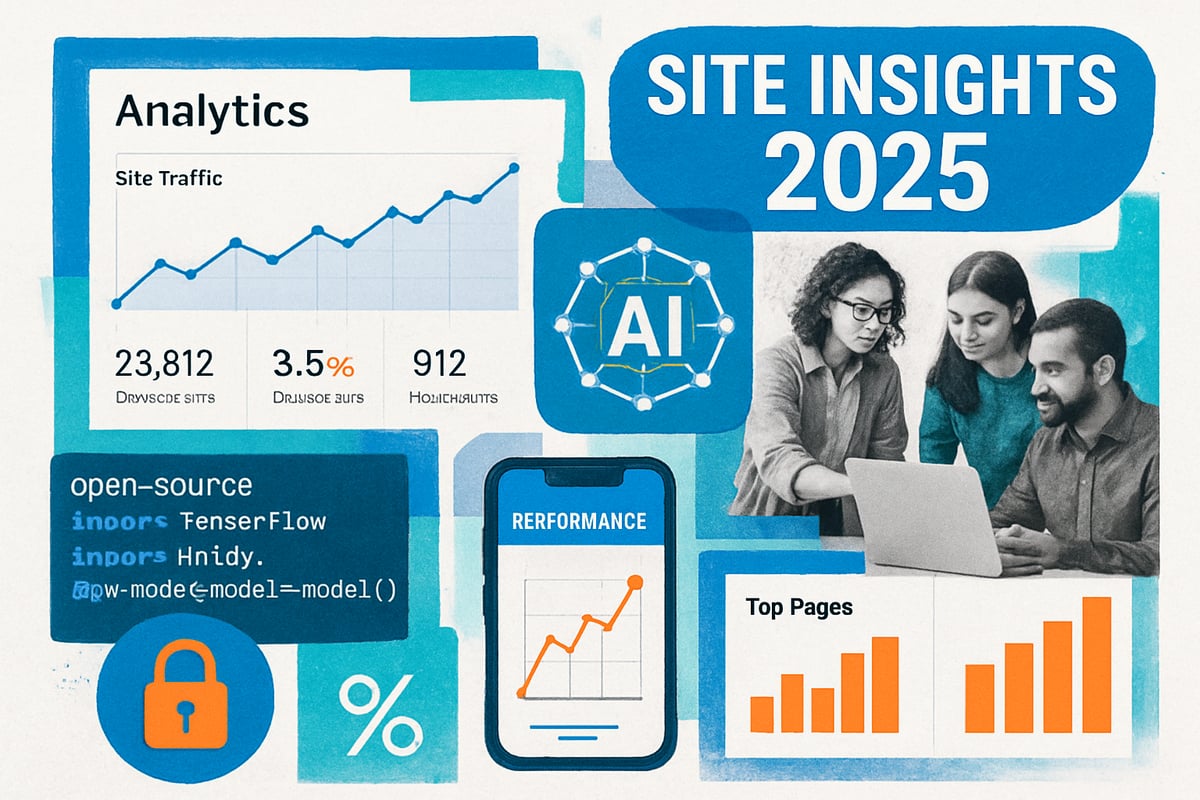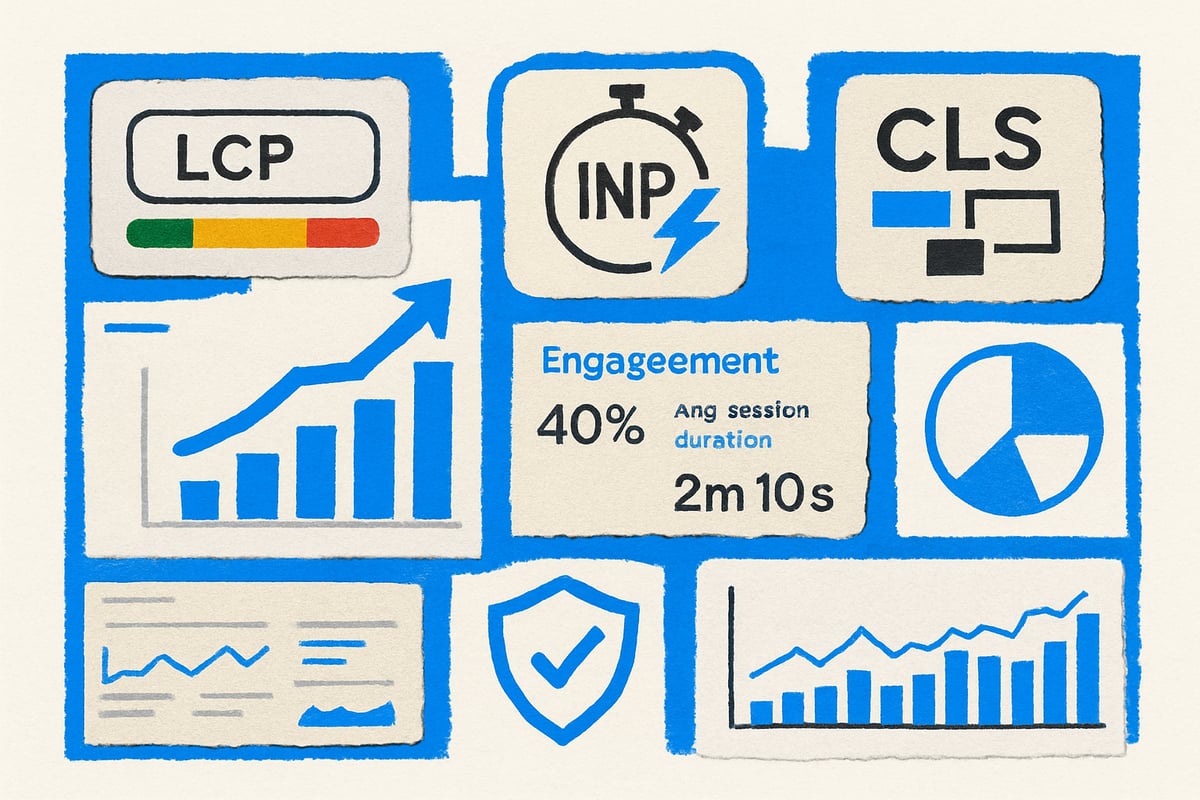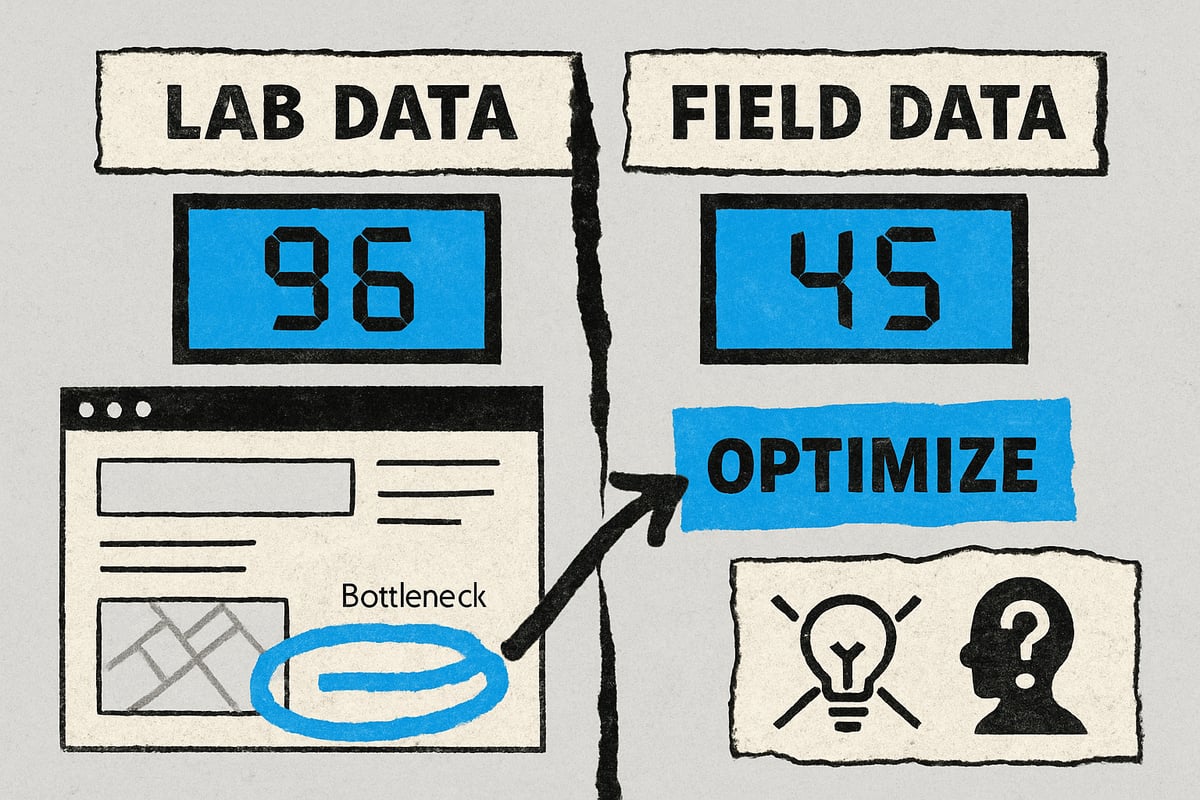- Date
Site Insights Guide: Unlocking Website Success in 2025
 Andrii Romasiun
Andrii Romasiun
In 2025, achieving website success requires more than just a visually appealing homepage or modern branding. The real differentiator is your ability to harness actionable site insights that drive measurable results, even as digital competition and algorithms continue to evolve.
This guide will demystify how to leverage advanced site insights to unlock your website’s true potential. Whether you are a website owner, marketer, or developer, understanding the latest strategies, tools, and metrics is essential for staying ahead.
Ready to increase traffic, boost user experience, and maximize conversions? Follow this blueprint to master the evolution of site insights, learn what to track, interpret your data, optimize performance, protect privacy, and future-proof your analytics for lasting success.
The Evolution of Site Insights: Trends and Technologies in 2025
In 2025, the landscape of site insights is rapidly changing as website owners seek deeper, actionable intelligence to drive digital growth. The demand for robust site insights is higher than ever, shaping how businesses understand user behavior, optimize performance, and maintain compliance.

The Shift from Basic Analytics to Actionable Insights
Site insights have evolved far beyond simple pageview counts. Today, organizations rely on advanced behavioral analytics, moving from basic statistics to understanding exactly how users interact with websites in real time. Traditional analytics tools, once focused on aggregate data, now offer deep insights into user journeys, click paths, and content engagement.
A major shift is the growing emphasis on real user monitoring (RUM) and field data. Unlike synthetic or lab data, which simulate user experiences, RUM collects data from actual website visitors. This approach provides a more accurate reflection of site performance and user satisfaction. For example, Google’s integration of Core Web Vitals into PageSpeed Insights leverages real-user data to grade website health.
The rise of machine learning and AI-powered analytics platforms is transforming site insights. Predictive analytics now help forecast trends, identify anomalies, and suggest optimizations before issues impact users. Cross-device and cross-channel tracking have become essential, offering a holistic view of user behavior as visitors move between devices and platforms.
These advancements enable businesses to transform raw data into actionable site insights, ensuring decisions are grounded in reality rather than assumptions.
Key Technologies Powering Modern Site Insights
The technology stack behind modern site insights is both sophisticated and privacy-conscious. Privacy-first analytics tools, such as cookieless tracking and GDPR-compliant platforms, are gaining traction as regulations tighten and user expectations evolve. Businesses are increasingly adopting these solutions to maintain compliance without sacrificing valuable insights.
Real-time dashboards and customizable alert systems empower teams to react instantly to performance shifts or errors. Features like session replay, funnel analysis, and error monitoring are now standard, helping teams pinpoint issues and optimize conversion paths with precision.
Open-source and self-hosted analytics solutions are on the rise. These platforms offer greater control over data, transparency in processing, and flexibility for customization. For example, many organizations now opt for open-source tools that provide 100% data ownership and compliance assurance.
APIs and automation further streamline analytics workflows, allowing seamless integration with other business tools. This not only saves time but also enhances the accuracy and utility of site insights across departments.
A recent trend is the increasing adoption of open-source analytics platforms, reflecting a broader push toward transparency, data control, and privacy.
Trends Shaping 2025
Several key trends are redefining site insights in 2025. User privacy and regulatory compliance are front and center, with GDPR, CCPA, and similar laws influencing analytics practices worldwide. The disappearance of third-party cookies and stricter browser privacy defaults are driving adoption of privacy-friendly solutions.
Mobile-first analytics is now crucial, as the majority of web traffic comes from mobile devices. Tools must accurately measure mobile performance, including speed, responsiveness, and stability. Google’s use of simulated mobile environments and real-user field data in performance scoring sets a new standard for site insights.
AI is playing a larger role in anomaly detection and automated optimization. Analytics platforms increasingly provide automated recommendations, helping teams act quickly on emerging issues. The convergence of analytics, performance monitoring, and SEO data creates a unified approach to digital optimization.
For a deeper dive into how AI and machine learning are shaping these trends, explore AI-Powered Web Analytics Trends.
Staying ahead in 2025 means embracing these innovations and integrating them into a future-ready site insights strategy.
Essential Metrics for Website Success: What to Track and Why
Understanding which metrics truly matter is fundamental for leveraging site insights in 2025. Today’s website owners need to move beyond surface-level stats and focus on the deeper indicators that shape user experience, SEO, and long-term growth.

Core Web Vitals and Beyond
Core Web Vitals have become the gold standard for evaluating your site’s real-world performance. These metrics—Largest Contentful Paint (LCP), Interaction to Next Paint (INP), and Cumulative Layout Shift (CLS)—directly reflect user experience and are major ranking signals in 2025.
| Metric | What It Measures | Google’s “Good” Threshold |
|---|---|---|
| LCP | Loading performance | <2.5s |
| INP | Interactivity | <200ms |
| CLS | Visual stability | <0.1 |
Tracking these metrics through site insights ensures your pages load swiftly, remain interactive, and avoid disruptive shifts. Google’s standards set clear benchmarks, and achieving them can improve both rankings and user satisfaction. Real-world data, like the Chrome User Experience Report (CrUX), is now essential for validating performance improvements.
Focusing on Core Web Vitals within your site insights workflow is not just about compliance—it’s about creating a seamless experience that keeps users engaged and returning.
Additional Performance and Engagement Metrics
Beyond Core Web Vitals, several other metrics provide critical context for site insights. First Contentful Paint (FCP) measures how quickly users see the first visual element. Speed Index (SI) tracks the speed of visual completion, while Total Blocking Time (TBT) and Time to First Byte (TTFB) highlight interactivity delays and server responsiveness.
These metrics directly influence user satisfaction and search performance. For example, Google’s PageSpeed Insights scoring formula weighs TBT at 30 percent, LCP and CLS at 25 percent each, and SI and FCP at 10 percent each. Understanding the difference between lab data (simulated tests) and field data (real user experiences) is crucial. Field data is more representative for ongoing site insights and optimization.
User Behavior and Conversion Metrics
Site insights go beyond technical performance—they shed light on how users interact with your content. Key engagement metrics include bounce rate, session duration, top pages, and conversion funnels. These indicators help you understand where users drop off and which pages drive the most value.
Custom event tracking, such as monitoring signups, purchases, or downloads, allows for tailored analysis. Campaign effectiveness is best measured using UTM parameters, which enable you to track specific traffic sources and conversions. For a practical guide on this, see Using UTM Parameters for Campaigns.
Modern analytics platforms often provide funnel visualization and event-based tracking, ensuring your site insights capture the full customer journey.
Error and Stability Metrics
Reliability is a cornerstone of positive user experience. Monitoring JavaScript errors, network failures, and layout shifts is vital for maintaining a stable site. Real-time error reporting, aggregated by browser, device, and location, helps pinpoint issues quickly.
By integrating error and stability metrics into your site insights, you can address problems proactively. This minimizes disruptions and protects your reputation, resulting in higher retention and satisfaction.
Privacy and Compliance Metrics
In 2025, privacy is inseparable from effective site insights. Tracking data collection practices for GDPR and CCPA compliance ensures your analytics are both ethical and legal. Monitoring consent rates and anonymized data usage is now standard.
Many analytics platforms have adapted by offering privacy-first features, such as cookieless tracking and not requiring cookie banners for basic metrics. Including privacy and compliance metrics in your site insights not only protects your organization but also builds user trust.
Interpreting Site Insights: From Data to Actionable Strategies
Unlocking the full value of site insights means moving from raw numbers to real improvements. Understanding how to interpret and act on your data is what turns analytics from a reporting tool into a catalyst for website growth. In this section, we will break down how to translate site insights into meaningful, measurable strategies.

Understanding the Difference Between Lab and Field Data
To make the most of site insights, it is essential to distinguish between lab data and field data. Lab data is generated in controlled environments using tools like Lighthouse or synthetic tests. This approach simulates user interactions, providing a consistent baseline for performance analysis. Field data, on the other hand, comes from real users navigating your site via tools such as the Chrome User Experience Report (CrUX) and Real User Monitoring (RUM) solutions.
Here is a quick comparison:
| Aspect | Lab Data | Field Data |
|---|---|---|
| Source | Simulated (Lighthouse) | Real users (CrUX, RUM) |
| Consistency | High | Variable |
| Use Case | Debugging, initial tests | Ongoing optimization |
| Limitations | Not always realistic | May lack granular context |
Field data better reflects actual user experiences, making it more reliable for ongoing site insights and optimization. Google aggregates field data over a 28-day window, ensuring trends are visible and enabling continuous improvement.
Decoding Performance Scores and Reports
Performance scores in site insights platforms, such as the 0-100 scale in PageSpeed Insights, offer a quick snapshot of your website’s health. These scores are influenced by several factors, including device and network emulation. For instance, mobile scores often differ from desktop due to simulated hardware constraints like the Moto G Power profile used in Google’s mobile tests.
When reviewing reports, pay attention to both the overall score and the breakdown of individual metrics. For example, PageSpeed Insights assigns weight to Total Blocking Time (30%), Largest Contentful Paint (25%), and Cumulative Layout Shift (25%). A low score in any of these areas signals a need for targeted action.
Remember, scores can fluctuate based on user location, network speed, and device type. Prioritize mobile performance if most of your traffic comes from smartphones. Interpreting these scores accurately is key to leveraging site insights for tangible improvements.
Identifying Bottlenecks and Opportunities
Site insights diagnostics are invaluable for uncovering performance bottlenecks. Reports typically highlight slow-loading elements, render-blocking scripts, and layout shifts that disrupt user experience. The “Opportunities” and “Diagnostics” sections in tools like PageSpeed Insights point to the most impactful areas for optimization.
Here are common bottlenecks to watch for:
- Large, unoptimized images delaying LCP
- Third-party scripts increasing TBT
- Unexpected layout shifts hurting CLS
By examining these insights, you can quickly identify what is holding your site back. Use segmentation to analyze performance by device, browser, and geography, which helps pinpoint specific pain points. Prioritizing these findings ensures your site insights drive targeted, effective changes.
Turning Insights into Optimization Steps
The true power of site insights emerges when you convert data into action. Start by addressing high-impact issues like image optimization, lazy loading, script deferral, and caching. For instance, moving non-essential homepage sections to separate pages can dramatically improve load speed.
Set up real-time alerts to monitor for performance drops or error spikes. Use dashboards to visualize trends and share progress with your team. For a deeper dive into actionable analytics, the Website Insights and Analytics Guide offers practical strategies for turning metrics into measurable website gains.
Remember, continuous monitoring and iterative changes are crucial. Site insights should inform regular updates, not just one-time fixes.
Avoiding Common Misconceptions
Misinterpreting site insights is a frequent pitfall. Here are a few myths to avoid:
- A perfect score is the only goal: Not every site needs 100/100, focus on user experience and business outcomes.
- All recommendations must be implemented: Some, like ad script optimizations, require balancing revenue and speed with async loading.
- Scores are static: They can vary due to time of day, user location, and device.
Stay critical and context-aware when reviewing reports. Use site insights as a guide, not an absolute rulebook. Informed interpretation ensures you make changes that genuinely benefit your users and your business.
In summary, interpreting site insights requires a blend of technical understanding and strategic thinking. With the right approach, you can transform analytics into a roadmap for ongoing website improvement.
Optimization Blueprint: Step-by-Step Strategies for 2025
Achieving measurable growth in 2025 demands a strategic, methodical approach to optimization. By following this practical blueprint, you can transform raw site insights into real business results. Each step is essential for gaining a competitive edge and ensuring your website delivers optimal performance, compliance, and user experience.
Step 1: Audit Your Website’s Core Metrics
Start by conducting a comprehensive audit of your current website performance. Use both lab data, such as Lighthouse reports, and field data from real user monitoring (RUM) tools. This dual approach ensures your site insights are both accurate and actionable.
- Run tests for Core Web Vitals: LCP, INP, CLS, and supporting metrics like TBT and FCP.
- Cross-reference results with user analytics to spot discrepancies.
- Benchmark against industry standards.
For those new to the process, understanding what is web analytics will help you grasp how site insights inform every aspect of optimization. This foundational knowledge sets the stage for the steps that follow.
Step 2: Prioritize High-Impact Fixes
With your audit complete, focus on fixes that will move the needle most for SEO and user experience. Your site insights will highlight which metrics are lagging and where optimizations will be most effective.
- Address slow LCP by optimizing large images and above-the-fold content.
- Minimize Total Blocking Time by deferring or removing unused scripts.
- Reduce Cumulative Layout Shift by reserving space for dynamic content.
Assign priorities based on the potential impact and feasibility, ensuring your resources are used efficiently.
Step 3: Enhance Mobile Performance
Mobile optimization is non-negotiable in 2025. Analyze your site insights to uncover mobile-specific performance bottlenecks that could be hurting user engagement and rankings.
- Compress and resize images for mobile devices.
- Limit the use of heavy animations and custom fonts.
- Simplify navigation and remove unnecessary elements from the mobile experience.
Testing on a range of devices and connection speeds will ensure your optimizations are robust and inclusive.
Step 4: Streamline User Experience and Conversion Paths
Use site insights to map out user journeys and identify where visitors drop off or get frustrated. By refining these pathways, you can boost conversions and enhance satisfaction.
- Analyze funnel reports to spot high-exit pages.
- Move heavy or non-essential content below the fold.
- Implement lazy loading for images and videos to speed up perceived load times.
Track user interactions and conversion metrics to measure the effect of each change.
Step 5: Monitor, Test, and Iterate
Optimization is an ongoing process. Leverage your site insights to set up real-time monitoring, alerting, and testing systems that catch issues before they impact users.
- Configure dashboards to visualize key metrics and trends.
- Set up alerts for performance drops or error spikes.
- Regularly A/B test new features or layout changes.
Continuous iteration ensures your site remains competitive as standards and user expectations evolve.
Step 6: Maintain Privacy and Compliance
In a privacy-first web, your site insights strategy must align with regulations like GDPR and CCPA. Choose analytics solutions that minimize personal data collection and respect user consent preferences.
- Use cookieless or privacy-friendly analytics platforms.
- Monitor consent rates and anonymized data usage.
- Review data handling practices regularly to stay compliant.
Integrating privacy into your workflow builds user trust and protects your business from regulatory risks.
Step 7: Future-Proof Your Analytics Stack
Finally, ensure your site insights framework is adaptable and resilient for the future. Opt for tools that offer flexibility, transparency, and scalability as your needs change.
- Embrace open-source or self-hosted analytics for data control.
- Integrate APIs for custom reporting and automation.
- Stay informed about emerging privacy laws and browser updates.
By future-proofing your analytics stack, you guarantee long-term value from your site insights investments.
Privacy-First Analytics: Navigating Compliance and User Trust
In the evolving digital landscape of 2025, privacy-first analytics is no longer optional. As site insights drive business growth, users and regulators demand transparency and data protection. To build trust and remain competitive, organizations must align their site insights strategy with the latest privacy standards.
The Rising Importance of Privacy in Web Analytics
Privacy regulations like GDPR in Europe and CCPA in California have reshaped how websites collect and process data. These laws require organizations to handle user information responsibly and grant users more control than ever. Major browsers are also phasing out third-party cookies, signaling a fundamental shift in how site insights are gathered.
The disappearance of traditional tracking methods forces companies to rethink their analytics approach. Failing to adapt can result in lost user trust and costly penalties. For a deeper look at these regulatory changes and their impact on site insights, see Data Privacy in Web Analytics.
Choosing the Right Privacy-Focused Analytics Solution
Selecting the right analytics platform is crucial for balancing actionable site insights with compliance. Privacy-first solutions minimize or eliminate the need for cookies, reducing legal risk and improving the user experience. Open-source and self-hosted analytics options are gaining traction, especially for industries handling sensitive data.
Key features to look for include:
- Cookieless tracking capabilities
- Transparent data processing
- Easy integration with your current tech stack
- No requirement for intrusive cookie banners
To learn more about privacy-friendly analytics approaches that support compliance and user trust, explore Privacy-Friendly Analytics Explained.
Ensuring 100% Data Ownership and Control
Relying on third-party analytics providers can expose your organization to data monetization risks and compliance challenges. With privacy-first site insights, full data ownership means you control what is collected, stored, and shared. Open-source and self-hosted platforms give you the flexibility to tailor analytics to your needs while maintaining strict access controls.
Benefits of full data ownership:
- Greater transparency into data flows
- Enhanced ability to meet regulatory requirements
- Reduced risk of unauthorized data use
This approach ensures your site insights remain accurate, secure, and aligned with your business values.
Building User Trust Through Transparent Analytics
Earning user trust starts with clear and honest communication about your data practices. Publish privacy policies in accessible language, outline what data is collected, and provide straightforward opt-out options. When users see your commitment to privacy-first site insights, they are more likely to engage and convert.
Consider these steps to foster trust:
- Display privacy badges or compliance certifications
- Regularly update your privacy policy
- Use analytics platforms that make anonymized, minimal data collection the default
Transparency not only protects your business but also strengthens long-term relationships with your audience.
[Swetrix: Privacy-First Analytics Platform](https://swetrix.com)
Swetrix exemplifies the new standard for privacy-first site insights. As a GDPR-compliant, cookieless, open-source analytics platform, Swetrix delivers actionable insights while ensuring full data ownership. Its real-time dashboards, error monitoring, customizable alerts, and team collaboration features empower organizations to make informed decisions without sacrificing privacy.

Swetrix requires no cookie banners and supports flexible self-hosting, making it ideal for startups, agencies, and privacy-conscious businesses. By choosing Swetrix, you future-proof your site insights strategy, maintain compliance, and build genuine user trust in a data-driven world.
Preparing for the Future: Adapting Your Site Insights Strategy for 2025 and Beyond
Navigating the future of digital performance means adapting your site insights strategy to evolving technologies, user expectations, and compliance standards. In 2025, success will depend on your proactive approach to analytics, automation, and team collaboration.
Embracing AI and Automation in Analytics
AI and automation are transforming how organizations interpret site insights. Modern analytics platforms harness machine learning to detect anomalies, generate predictive reports, and recommend optimizations in real time. By leveraging AI Integration in Digital Analytics, businesses can automate routine reporting, freeing up teams to focus on strategic improvements.
AI-driven site insights help you spot performance trends and user behavior shifts quickly. Automated alerts ensure you never miss critical changes, keeping your website agile and competitive.
Integrating Site Insights with Broader Business Goals
To maximize value, align your site insights with your organization's marketing, sales, and product strategies. Use funnel analysis to identify friction points in user journeys, and connect custom event tracking to business KPIs like conversions or revenue growth.
Site insights become a strategic asset when they inform campaign decisions and product iterations. Cross-team dashboards and regular reviews help ensure everyone benefits from actionable data.
Building a Resilient, Scalable Analytics Stack
A future-ready analytics stack should scale with your needs and adapt to changing regulations. Opt for flexible tools that support API integrations, open-source solutions, and privacy-first features. Consider server-side tracking for improved accuracy and compliance, as described in Server-Side Tracking Benefits.
By investing in robust site insights infrastructure, you ensure data integrity, transparency, and long-term adaptability for your digital presence.
Continuous Learning and Team Enablement
Empowering your team to interpret and act on site insights is essential for ongoing improvement. Regular workshops, knowledge-sharing sessions, and shared dashboards keep analytics top of mind.
Encourage collaboration between technical, marketing, and product teams. A culture of continuous learning ensures your organization stays data-driven and responsive to new challenges.
Staying Ahead of Industry Changes
Staying proactive with your site insights strategy means keeping up with analytics standards, privacy laws, and browser updates. Participate in analytics communities, read industry reports, and monitor updates from key platforms.
Anticipate changes to regulations or scoring methods, such as updates to Core Web Vitals. Adapting quickly to new requirements will protect your site's performance and reputation.
As we look ahead to 2025, staying competitive means more than tracking page views—you need actionable, privacy-first insights that empower you to optimize every aspect of your site. Swetrix makes it easy with intuitive dashboards, real-time error monitoring, and customizable alerts, all while respecting your users’ privacy and giving you complete control over your data. If you’re ready to embrace a future-proof analytics platform that keeps you compliant and informed, now’s the perfect time to take the next step.
Try Swetrix today and unlock your website’s full potential with confidence.